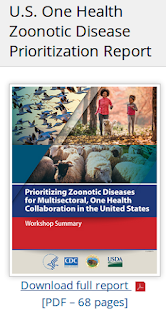#17,569
A little over 4 years ago, in CDC: The 8 Zoonotic Diseases Of Most Concern In The United States, we looked at 68-page report (One Health, Zoonotic Disease Prioritization for Multi-Sectoral Engagement in the United States) that listed and ranked the top 56 zoonotic threats to the United States.
While many of these disease threats were already entrenched in the U.S. (e.g. salmonellosis,
West Nile virus, plague, rabies virus, brucellosis,
and Lyme disease, etc.) some were exotic, and rarely - if ever - reported in North America.
At that time, the 8 zoonotic diseases of most concern in the U.S. were listed as:
- Zoonotic influenza
- Salmonellosis
- West Nile virus
- Plague
- Emerging coronaviruses (e.g., severe acute respiratory syndrome and Middle East respiratory syndrome)
- Rabies
- Brucellosis
- Lyme disease
Of these, Emerging Coronaviruses and Zoonotic Influenza were the most exotic, having only rarely been reported in the United States.
But times - and zoonotic threats - change.
Eight months after the publication of this list, an emerging coronavirus (SARS-CoV-2) spilled out of China, killing millions of people in the worst pandemic in a hundred years. Three years later we also find ourselves - and the rest of the world - dealing with the unprecedented spread of zoonotic avian H5N1.
But other anticipated threats have been on the move as well.
Number 29 on this list was Monkeypox (now Mpox), which 4 years ago was pretty much confined to Nigeria and central Africa, with only a handful of cases exported outside of the region. That is, until just over a year ago, when we discovered that Mpox had begun to spread internationally (see CDC map below).
Also on this watch list was Melioidosis (#32) - aka Whitmore’s disease (caused by a Burkholderia pseudomallei infection) - a bacteria which is normally found in tropical regions (primarily Southeast Asia and northern Australia) - but had not (at least, in 2019) been found in the continental United States.
A year ago, however, we got the following warning from the CDC (see CDC HAN Advisory: Melioidosis Locally Endemic in Areas of the Mississippi Gulf Coast).
Murine Typhus (#52 on the list), which we looked at in 2017's Texas: DSHS Issues Murine Typhus Alert, had only been rarely reported in Southern Texas, averaging 157 cases per year from 2000 to 2016. Those numbers began to rise in 2017, with Texas (see chart below) reporting a 4-fold increase in cases since 2020.
Bacterium Associated With Disease Found in N.C. Chiggers
July 12, 2023
A bacterium that causes a disease called scrub typhus – a disease not previously reported in the United States – has been detected in North Carolina, according to a new study by researchers at North Carolina State University and UNC-Greensboro.
The researchers stress that scrub typhus, which can cause fever, headache and body aches – and can be fatal if left untreated by antibiotics – has not yet been detected in animals or people in the state.
The NC State researchers detected the bacterium – the genus is Orientia in the family Rickettsiaceae – at a high frequency while testing free living, larval (ready to bite) trombiculid mites, commonly called chiggers, in several different recreational parks in North Carolina
Twenty-five years ago West Nile Virus was unknown in the Western Hemisphere, now it is endemic, and infects thousands of people every year. Locally acquired Dengue and Malaria cases - while still rare - are rising (see CDC HAN: Locally Acquired Malaria Cases Identified in the United States).
We've been very lucky that MERS-CoV (#6), Nipah and Hendra (#20 and #37), and the hemorrhagic viruses like Ebola, Marburg, and CCHF (#16, #38 and #15 on the One-Health Hit parade) haven't made similar inroads.
Humans are not the only ones at risk. Agricultural diseases like Rift Valley Fever, FMD, African Swine Fever (ASF) - or any number of plant diseases - could devastate food production and cause tens of billions of dollars worth of damage.
And some - like swine coronaviruses - may even have zoonotic potential.
These threats (and more) are all on the move in this 21st century; propelled by climate change, our ability to travel (or transport goods) rapidly to anywhere on the globe, and our continued incursion into remote, undeveloped regions of the world.
While most of these disease threats won't rise to pandemic proportions, they can (and undoubtedly will) exact a heavy toll in the years ahead; in terms of individual health, healthcare delivery, and economic damage. And somewhere in this mix are likely a pandemic contender or two.
The CDC actively follows 23 subtypes of Zoonotic Influenza on their IRAT List, and as we discussed last May in China: Emergence of a Novel Reassortant H3N6 Canine Influenza Virus, new subtypes with pandemic potential continue to emerge.While it is easy to get lost in the constant drum beat of H5N1 reports, we are just as likely to be blindsided by something not on our radar. Just as we were in 2009 with the swine-origin H1N1 virus, and in 2020 with SARS-CoV.
Unfortunately, surveillance and reporting of zoonotic diseases remains suboptimal in many regions (see Lancet Preprint: National Surveillance for Novel Diseases - A Systematic Analysis of 195 Countries), and international tensions and economic priorities often conspire to further cloud the picture (see Flying Blind In The Viral Storm).



